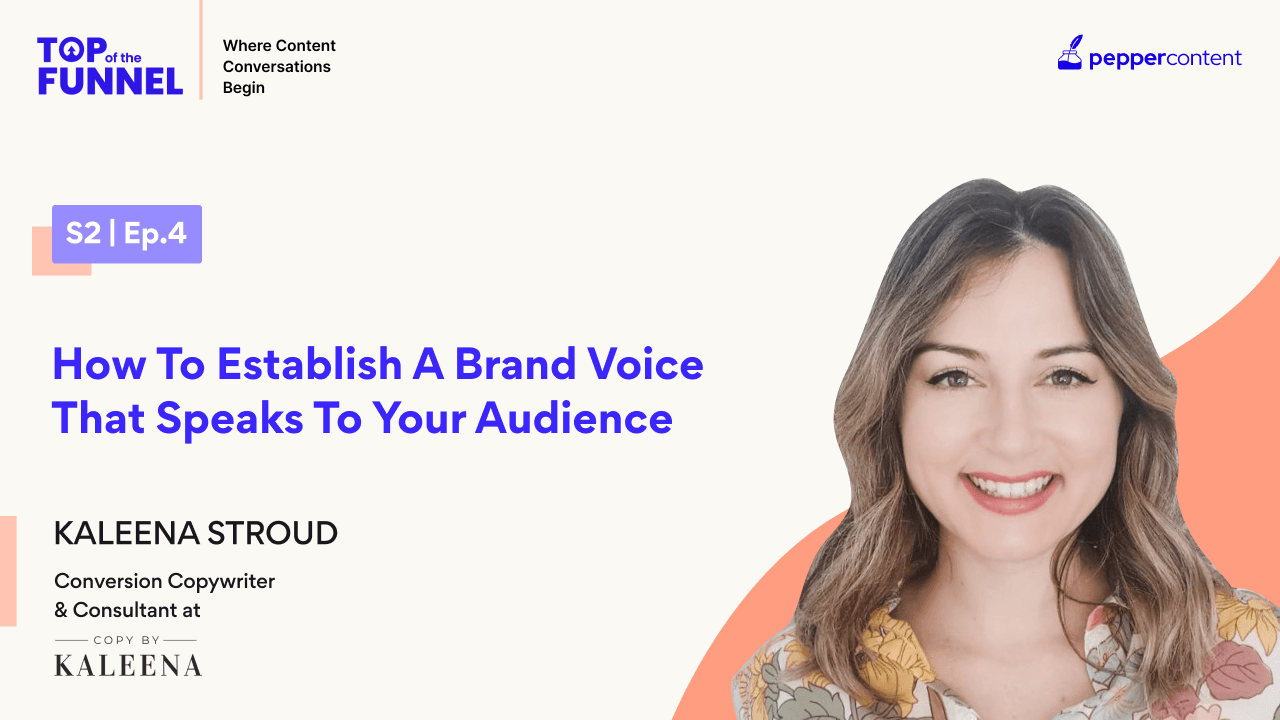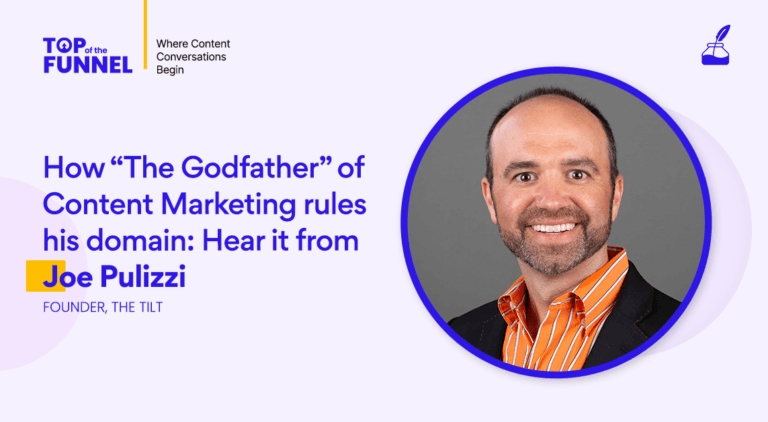How to Establish a Brand Voice That Speaks to Your Audience

To build a successful business, it is quintessential to stand out among the competitors and a sure shot way to achieve this is through establishing meaningful connections with the target audience and improving the relatability factor. This is where the importance of brand voice kicks in.
In this episode of Pepper Content’s Top of the Funnel, Natasha Puri, Content Marketing Lead at Pepper, dives into a conversation around brand voice and writing with Kaleena Stroud, freelance conversion and copywriting consultant at Copy by Kaleena.
Kaleena Stroud: The whole time I’ve been a copywriter, I’ve naturally been helping customers shape their brand voice because I think I’ve always called it my superpower. Getting to know who they are, and how they want to stand out, and using language to do that. Since I am a writer, it’s just kind of fun. I studied creative writing. I mean, it could go back to university when I started creative writing. And you talk about things like tone and writing style, right? It’s easier when you have that knowledge to pay attention to how people are writing and just make sure you always sound like people. So people always just say – oh, you sound like me. You got my voice just right. Or I said I wanted to be funny, but you understood exactly what kind of funny I meant and made it come out.
So I just found out that – oh, I guess I’m pretty good at the brand voice. And then I started asking around the copywriting circle because it’s quite small at the end of the day, and people were like, yeah, we sell brand voice. You can do that as a niche. I think I started working on it last year, finding out how to put together a framework. So it’s really easy for me to work with people just with voice. And then I launched in January and it took off. I think just because I’m so outspoken on LinkedIn people noticed that I was starting to talk about this new part of copywriting.
Natasha Puri: That’s amazing. I think it’s not just that brands struggle with it. I think when brands work with other writers, they struggle with giving them the right guidelines as well. So as a result of it, when you outsource a lot of content, you just have content that doesn’t sound like anyone and it’s a huge mess. So I think it solves a problem for the writer as well as the brand. Right?
Kaleena Stroud: Yeah, it’s a huge win-win. We could get into what a guide could entail so that both parties are happy. But one of the biggest reasons why creating a document for your brand voice is so important is so that your writers know how to represent your voice. And especially if you’re trying to steal your content and you have to hire ten different writers, you want to make sure that they all sound the same. That can be difficult if you don’t give them the kind of parameters to do that.
Natasha Puri: I was just reading a survey in which this is one of the biggest pain points for marketers who are working with freelance creators that they find it very difficult to communicate the brand voice.
Kaleena Stroud: It’s not easy because everybody has their style and I always say so. Usually, when people hire freelancers, you can look at what they’ve written. And editors tend to hire based on – okay, they sound like our style. So you might just find someone who naturally fits. You never know how much the editor edited the brand voice on their end. And so the final piece in the sample that you’re looking at actually has been edited. And then some editors are picky like – oh, we wouldn’t even say that word – which is fine, but then editors have a lot of work to do. So if you’re hiring a lot of writers, you need to make sure they all sound the same. I get it.
Natasha Puri: I’m going to ask you something super basic, which is what is the brand voice and why is it even important?
Kaleena Stroud: Brand voice essentially is, I just like to simplify it and call it your personality. At the end of the day, people like to work with people. So how do you get that to come across in your writing? And it consists of three basic things. You’ve got your tone, your cadence, and your vocabulary. And I’ll quickly touch on those but we can dive even deeper and get nerdier for sure.
Your tone is the fun part. It’s how your emotions are expressed through your writing. So you could be excitable like I am, and use lots of exclamation marks and emphasis and descriptive words and things like that. Or you could be rather reserved and monotone, which is fine either way. It can be very serious and funny, friendly and open, or reserved. So those are your basic places to start when you’re thinking about tone. And then, of course, you need a lot more detail and we can discuss how I get down into detail about that kind of tone. But that’s one part.
The next one is cadence. So that’s the rhythm or the length of your sentences. If you have really short ones, maybe even three words or four-word sentences, get to the point. Or you like long and languid and showy sentences. That takes a user on a journey and you’ve got lots to say. Or you could be in the middle of a mixture of all those things. This part, as a writer, I like to get nerdy about it, but all you need to know is short medium or long sentences with your cadence.
Lastly, there is vocabulary, which is whether you like simple language or if you like the complexities of language and you like long, complicated words, which is again, there’s no right or wrong answer, it’s just defining which ones you use. So those are all those three things together to create your brand voice.
Natasha Puri: Why is it so important for brands to have a brand voice? And I’m talking in terms of companies that are relatively new and looking to build a brand. Why does this become so important? And talk to us about your experiences or even working with these brands.
Kaleena Stroud: I’ve worked with people who are just struggling to write. So let me start with the main reasons why brand voice is important and I could tell you a little bit about the type of people I work with and why they come to me. One is, it’s going to help you stand out from the crowd. It’s your personality, it can help you stand out. And I think a lot of companies kind of get scared at brand voice because they think that if we want to go develop a brand voice or invest money into a brand voice, it means we want to be funny out there, and wacky and veiny like you see on social media with Twitter and stuff, and you think you need to be like liquid death, which is kind of making a splash in marketing because of their brand voice. This is because they imagine that those brands get a lot of attention because of their brand voice. But in reality, no matter what you write, if you have a brand voice, you might as well make it purposeful for many different reasons. So you don’t have to be that crazy to stand out from the crowd, you just need to look at your competitors in your vicinity and see what they’re doing because if everybody is super authoritative and buttoned up like – we have the answers – maybe you want to be the one that’s a little bit more vulnerable or a little bit more open and give your customers something they haven’t experienced before in your space. If everybody has a goody two shoes and a cute brand, maybe you want to be a little bit of a rebel, which is kind of what liquid death did. But on a scale of like a ten, you could always do it on a scale of a two, right? So that stuff just makes you look different with your voice. You don’t have to always do it like competitor research. You just need to be purposeful, because if you’re purposeful with your brand voice, then people are going to remember you anyway because like I said earlier, people like to do business with people. So if you just have that kind of confident voice coming through, they’re going to remember you a little bit more, connect with you a bit more. So it helps you become relatable. And that is for your audience to remember you.
And then, of course, one of the biggest reasons why is to scale your content, hire writers, be consistent and sound like you, and be able to produce more work. And that’s hard to do unless you’ve defined your brand voice. So it is a foundational piece of your brand identity. A lot of people, when they start building their brand, they’re like – okay, we got our visual identity – and they’ve got a 20 to 50-page document about visual and brand identity with their missions and values, and then they stop there. But the third piece is your voice and it deserves just as much attention as your visual identity is your verbal identity. So if you’re creating those foundational pieces, you also do the voice. Nowadays, I do find more people coming to me. Maybe it’s because I’m just speaking about brand voice more that they are coming and saying – hey, we’re launching a brand and we need help with voice. But most people come to me because they just struggle with writing. After all, they know what they sell, but they don’t know how to get their messages out there. They don’t know who they are. They’re having an identity crisis. So that’s usually when they have that pain point of struggling to get their words out there.
Natasha Puri: So I think you’ve developed this Chameleon brand guide. I’d love to understand the framework that you have developed and maybe you can tell us, and give us examples of how to apply that a little bit.
Kaleena Stroud: So the Chameleon brand voice is made up of the WILD framework, so W, I, L, D, and it’s very closely connected to the three elements of brand voice I mentioned earlier. So anybody could take this framework and use it if they want to start putting together guides. But it’s the one I use when I’m working with people one on one. And bear with me, it’s a little bit long because again, this is a foundational part of a brand, so there’s a lot of work that goes into it. But to give you the gist, you have the W, which is your words. It’s the vocabulary. So we’ll look at regional slang. Like in the US, you might say pop instead of soda. If you’re from the US versus the UK, a little bit more international types of spelling. You want to look at jargon. If you use jargon or you don’t, that’s going to depend on your audience. You want to make sure you’re speaking their language too, and stuff that they understand. So you want to write down what kind of jargon you use in your space. So just list out how you name your products, and your services, for example, Pepper Content. I think you can correct me if I’m wrong, but I thought it was called creators. You don’t always say the word freelancers. People are called creators. So that’s a specific way you call freelancers. So you want to make sure that’s always consistent. So just naming down those words like that. You can also get super specific and say creator, capital C, not creator lowercase c, not a freelancer. So that’s a mixture of a style guide as well, but that can all go together under W. It can also be a word you don’t use. I think that’s always really fun. I’ve worked with a lot of skincare companies in the past and they’re all going away from the word antiaging. So a lot of the documents we put together don’t use the word antiaging. We use pro-aging instead. For example, that’s under words to make sure people aren’t using terms that you don’t want to be using anymore or outdated terms.
Next, we’ve got I, which is -isms, like your mannerisms. I’ve added this one because I do work with personal brands as well and they’ve got more of those quirks. It’s not as long as you come to B2B companies, but with personal brands, they have a lot of -isms. So that could be just phrases that come out of your mouth naturally, a whole bunch. I worked with a client the other day and it was a marketing company, but she was the face of the marketing company, so it was under her voice and she used a lot of adverbs. And so if you look at best practices on the Internet, it discourages the use of adverbs because they’re weak forms of writing. But she used a lot of adverbs. So that’s also why it’s important to have these guides because if you’re a writer, you might never use an adverb thinking – oh, standard practices, don’t use an adverb. But then she’s going to read this writer’s writing and say, this doesn’t sound like me because it doesn’t have a single adverb in it. So we have to mention things like that. Like, we love adverbs here, but instead of saying the word likely, we might say theoretically. Instead of saying very, we’ll say utterly or highly. She likes quirky adverbs, so what does that look like? And so we put that under isms. It could also be cursing. That’s a really fun one for me. So if the brand curses a lot, like how do they curse? What’s too much? What’s too little? Do we spell out the curse word? Do we put an asterisk so we’re bleeping it out? Those fun parts kind of go under -isms.
Next, we’ve got lengths, which again is like the cadence of the length of your sentences. So I’ve got a couple of tools that you can plop in some documents and it’ll mathematically calculate the rhythm of your sentence. So a lot of people go medium, long, short. That’s a really good way to write a paragraph if you’re losing attention and then you come in with a short sentence and that gets people in again. So if you’re really into writing, you can get that nerdy about it. That stuff is really important because you’ll visually see the link, right? Think about a LinkedIn post. Some people have like three words- seven words and some people have the standard one. I have a mixture of maybe six to seven words. So visually, you’d see that on LinkedIn, right? So that’s the kind of stuff that would go under length if you’re very picky on that.
Lastly, there’s delivery, which is the tone. It is the more difficult part because that’s where a lot of companies try to put their brand voice and they’ll say – we’re friendly and authentic – and so they come up with a couple of words, but that’s not good enough for a writer. It’s not saying much. It’s kind of like saying to a designer that we use red and green. I don’t know what to do with that. Red and green. I need specific shades and stuff. So I always say to brainstorm at least 20 different words. And you can go to your audience and just post something on Instagram, like, describe us in one word, or send out an email to get a collection of words and then use that to group them together, because you’ll get similar things. Once you group them, then you can choose your pillar voice, which might be friendly, but now you’ve got at least some color to it. So, for example, you might get bubbly, playful, and joyous, and then those could all be grouped under positive, right? But if you said we’re positive and friendly, that doesn’t say much. But now if you say we’re bubbly and we’re playful, that gives the rater a lot more to work with. That even gives the brand a lot more sense of identity. Same thing with funny. What type of funny are you? Are you sarcastic? Do you like dark humor? Are you punny? Do you like just putting things on the side? Are you self-deprecating? There are so many shades to these words. So it’s just about being very specific. Also, if you can give actual examples, like here’s a sentence of us being funny, here’s an example of us being bubbly, this is what it looks like. You can also try this but not that method to put you in the middle – We are vulnerable, but we’re not self-deprecating. It’s just put somewhere in the middle. So basically, that would be the entire part of a brand voice.
With my chameleon guide, we can sometimes get upwards of 50 pages. I would call the WILD framework which might be 10 pages, 20 pages even. Sometimes my guides could even go to 40 and 50. If you’re putting a lot of examples and you’re doing competitor research such as this is what the competitor sounds like, this is what we sound like. And then, of course, a style guide added to it could easily make that 40 pages because then you’ve got all your lexicon and stuff. But to not be overwhelmed with thinking about creating a 40-page guide, you can just start with the wild framework and that’s going to be plenty for everybody to work with for sure.

Natasha Puri: I’ve been talking about stuff from a brand point of view, but at times I feel like a lot of the brand voice needs to be a reflection of the audience or the target persona that they’re targeting. So does that factor in any way in finding the brand voice?
Kaleena Stroud: Yeah, it should be a mixture of the two. I would say that with the W, the words, just go around and research how they speak about your product. Sometimes I just put in word banks. If you don’t know what to do with those words yet, you could just create a word bank. We call it a sticky copy. You might want to say your product is unique, but your customers are probably not going to say it’s unique. So just go and find out how they’re talking about your product. If you haven’t launched yet, you just go and see how they’re talking about things in your space and grab little phrases that sound like – I never would have thought of that, or I never would have described it like that – and just putting that in your document and using that as like a grab bag of phrases can be helpful under words. And any good copywriter will know what to do with that when they’re writing because that’s more like with website copyright. That stuff is really important in your email copy to be reflecting how your customers speak. When you use this guide to the content, you’re educating and that’s when they’re connecting with your personality. So I don’t think you need to include as much voice of customer data in your actual content, but for web copy, that’s important. So just doing that research to grab a sticky copy.
Again with jargon, understand the level of knowledge so that you are not speaking down to them because they understand, and also don’t speak too high up that they get confused. So decide how you’re going to be talking about jargon, if you’re going to introduce a word, then briefly explain it in a paragraph and get specific. Introduce a term and then put it in parentheses because that’s all that they need to know to remember very quickly. That’s one way. Again with the tones. If you’ve already launched and your customers have already started, you have some success. So a lot of people come to me at that point when they’re doing well, but need help with getting more copies out there. And you go to your audience and say – what do we sound like to you? You’re giving them more of that. You can also look at your highest performing content, a really good ad, a blog post that did well, an email where people were like – oh, I love this – and they message you back, that’s content that they want to see from you. So you can look at those pieces for your tones and see what attracted those customers to you and give them more of that. So that’s good.
If you want to help your copywriters, I would say adding in just more of those work banks and things like, this is exactly our pain points and stuff, but then we’re kind of talking a little bit more about brand identity and doing some of the work with copywriters. When you hire a copywriter, they should be doing this stuff for you anyway. If you don’t know what the voice of your customer data is like, I don’t want to do that. I want to hire a copywriter to do that stuff for you. They could also be providing that stuff separately.
Natasha Puri: Okay, so now let’s pull back. I think there are a lot of valuable nuggets, even for writers, right? And of course, you work as a freelance writer. So if you can simplify this, I know it’s a very broad question, but can you give me some tips about good writing? How do you define good writing?
Kaleena Stroud: Yeah, a couple of different things. So in this context, I think any good writer, even if you don’t have a brand voice, should be reading your content and getting a feel for your brand voice and who you are and trying to represent you. And a great writer will do that accurately. But of course, giving them a guide will help. But I think good writing at the end of the day is good writing and brand voice punches it up and helps in a lot of ways. But anyway, just good writing to me is a little bit more general. So I would say it’s purposeful. So always sitting down and thinking, what’s the goal of this writing in marketing speak, what’s the CTA? It should always have one takeaway you want your audience to have. Because what happens is a lot of writers or sometimes a lot of entrepreneurs, they just are so excited and they say – oh, but we also do this and we also do that, and we also offer this – then that’s when things get muddy and your audience gets confused. Having one clear goal and purpose for your writing is good.
Next, I would say it’s clear and concise. And I think any writer would say that if you have a goal, think it’s going to be more clear, right? Because you know what point you’re trying to get across. Also being concise would be being ruthless in your editing process. So editing, editing, editing, saying, how can we say this in half the number of words, right? It’s being consistent. So with your words, your length, your tone, that’s when style guide comes in, like your spelling, how you use your commas, how you use M dashes, all that stuff should be consistent. And you can add consistency errors that are like, we sail ends at midnight, and the next day they sailed in at seven. That’s a big consistency error. But even the small ones, like changing up how you called something or an opinion, that stuff even as small as a comma sometimes can throw off your readers even if they don’t necessarily realize they’re being consistent.
And then lastly, I would also say confidence in your writing. So that’s why a brand voice can help as well. Because people who stand out and attract leads or people and audiences are confident in who they are and what they want to say and how they want to say it. And if you’ve got a strong opinion, you got strong values, that type of confidence, that helps your writing stand out. And even if you’re like a vanilla opinion person and you stay in the middle, as long as that’s consistent, clear, and purposeful, that’s okay too. So it all comes together because again, I don’t like to say there’s any right or wrong way to have a brand voice. All those together make great writing at the end of the day.
Natasha Puri: What are the few things that brands can do to make the lives of freelancers easier? We discussed this before we started jumping into this conversation about how a guideline benefits the brand as well as the writers that they work with. Because at the end of the day, there is a misalignment when you get articles from freelancers that just sound very different from what you are trying to project as a brand. So what are a few things that brands can do better?
Kaleena Stroud: They can provide an onboarding document. It could be a brand voice guide that we talked about. It could be just a style guide. It should be a combination of both, in my humble opinion. I’ve been a freelance writer for eight years at least. And maybe two companies have given me a style like an onboarding guide. And like I said before, a good writer will go and try to figure out your voice and read your old content so they sound like you. But why not make their life easier and just give them a – hi, this is what we like to see. And so, again, be very specific with your brand voice. I had an example of one of the first ones I ever received, and I was like, wow, this is so helpful from a travel company. And they described – here’s the type of content we produce. We produce personal stories, and we produce a top ten list of goals and places to visit, but they’re always from people who are here. So this is the type of content we want to see. That stuff is so helpful. Instead of trying to figure out who this brand is, they also said, we hate generalization, so don’t ever say anything like sweeping this does or hidden gem. That’s kind of cliche in the travel industry, so we don’t want that. So that stuff is super, super helpful.
You can also add an onboarding process. So this is what working together is going to look like. So that’s great for onboarding your writers. The ones that I receive a lot from B2B companies are just like lists. Don’t turn in your document until you’ve checked your H1 until you’ve added SEO until you’ve done. That stuff is fine for the editor, but it’s not going to help your writer become a better writer for you. So I think all those things need to be combined. Again, fleshing out the style guide, how’s your grammar and punctuation, and all that stuff is going to make your writers feel empowered to represent your brand well. And cut down on the editing process because I know a lot of editors feel – oh, it’s just easier for me to just edit this because this isn’t on brand. And then your writer never really knows what might have been off. So just hand them a guy that says what is kind of off for us and what’s on brand, and everything’s going to be more streamlined and your writers are going to have the tools that they need to write correctly for you. And again, these guides could be long, but you’ll just jump to the parts that you need right when you need them. So that’s kind of what it’s there for, and it’s a win-win for both people.
Natasha Puri: That’s great. Kaleena, I told you, we’ve been struggling with the brand guide of our own, and it’s so critical, not just for, you know, to work with freelancers, but I think internally because now there are multiple people creating content, multiple stakeholders. So having a cohesive voice that sounds like one brand and not ten is super important. I loved this session. I loved takeaways as a marketer and also takeaways as a writer. I think we checked both boxes. I think this is exactly the kind of session that would interest both of these kinds of audiences.
Latest Blogs
In this blog, explore the golden rules of using AI marketing tools so you can leverage the benefits to their maximum potential.
In this blog, you’ll learn how to avoid the pitfalls of SEO over-optimization while enhancing your site’s performance.
In this article, we’ll take a look at what AMP is, its advantages and disadvantages, and how it affects SEO.


